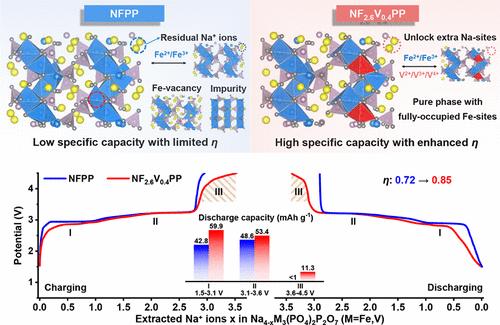铁基混合磷酸盐阴极增强容量和纯相形成的机理研究
IF 15.6
1区 化学
Q1 CHEMISTRY, MULTIDISCIPLINARY
引用次数: 0
摘要
铁基混合磷酸盐Na4Fe3(PO4)2P2O7因其结构稳定性和成本效益而成为一种很有前途的钠离子电池正极材料,但其容量受到杂质相和铁氧化还原活性不足的限制。我们引入了电活性系数(η = C/I),其中C是氧化还原对的数量,I是每个配方单位转移离子的数量,作为高容量阴极的设计度量。分析表明,Na4Fe3(PO4)2P2O7的η值为0.72,采用v掺杂策略增强多电子转移,η值达到0.85。V掺杂还触发了Fe2+的高自旋到低自旋转变,缩短了Fe-O键,增加了fe空位形成能,从而抑制了杂质。优化后的Na3.6Fe2.6V0.4(PO4)2P2O7在0.1℃下的容量达到了创纪录的124.6 mAh g-1。这项工作阐明了相纯阴极的形成,并建立了高容量电极的通用设计原则。本文章由计算机程序翻译,如有差异,请以英文原文为准。

Mechanistic Insights into Enhanced Capacity and Pure-Phase Formation in Fe-Based Mixed Phosphate Cathodes
Fe-based mixed phosphate Na4Fe3(PO4)2P2O7 is a promising sodium-ion battery cathode due to its structural stability and cost-effectiveness, yet its capacity is limited by impurity phases and insufficient Fe redox activity. We introduce an electroactive coefficient (η = C/I), where C is the number of redox couples and I is the number of transferred ions per formula unit, as a design metric for high-capacity cathodes. Analysis reveals that Na4Fe3(PO4)2P2O7 has a suboptimal η (0.72), prompting a V-doping strategy to enhance multielectron transfer, raising η to 0.85. V doping also triggers a high-spin-to-low-spin transition in Fe2+, shortening Fe–O bonds and increasing the Fe-vacancy formation energy, thus suppressing impurities. The optimized Na3.6Fe2.6V0.4(PO4)2P2O7 achieves a record capacity of 124.6 mAh g–1 at 0.1 C. This work elucidates phase-pure cathode formation and establishes a universal design principle for high-capacity electrodes.
求助全文
通过发布文献求助,成功后即可免费获取论文全文。
去求助
来源期刊
CiteScore
24.40
自引率
6.00%
发文量
2398
审稿时长
1.6 months
期刊介绍:
The flagship journal of the American Chemical Society, known as the Journal of the American Chemical Society (JACS), has been a prestigious publication since its establishment in 1879. It holds a preeminent position in the field of chemistry and related interdisciplinary sciences. JACS is committed to disseminating cutting-edge research papers, covering a wide range of topics, and encompasses approximately 19,000 pages of Articles, Communications, and Perspectives annually. With a weekly publication frequency, JACS plays a vital role in advancing the field of chemistry by providing essential research.

 求助内容:
求助内容: 应助结果提醒方式:
应助结果提醒方式:


